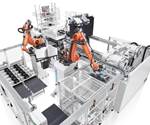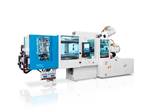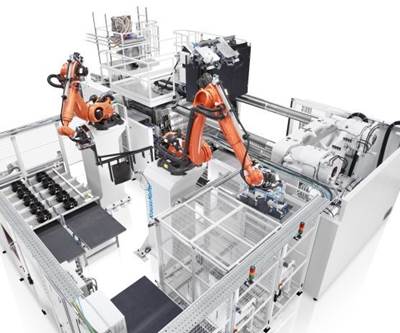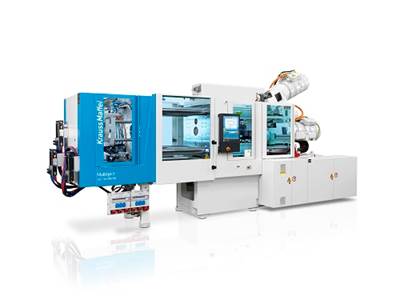KraussMaffei and NIAR Propel Injection Molded Thermoplastic Composites
The maker of plastics processing equipment has placed a machine and an injection molding expert in NIAR’s ATLAS lab in Wichita, Kansas, to help molding, composites and aerospace take off.
KraussMaffei (KM) is working to bring its automated, high production-rate, injection molding-based thermoplastic composite technologies to the burgeoning advanced and urban air mobility markets. In partnership with Wichita State University’s National Institute for Aviation Research (NIAR) and its Advanced Technologies Lab for Aerospace Systems (ATLAS) operation, KM has installed a 450-ton multimaterial injection molding machine to support high-pressure resin transfer molding (HP-RTM), ColorForm polyurethane overmolding and the FiberForm process for infrared oven preheating of composite sheets.
Established in 2019, ATLAS was conceived as a makerspace for industry-scale automated composites manufacturing research, including automated fiber placement (AFP), fiber patch placement for complex geometries, thermoplastic welding, and thermoplastic overmolding for multifunctional integrated structures. In 2023, ATLAS received AS9100D and ISO 9001 certification concurrently to expand its support to industry for automated manufacturing, nondestructive inspections and machining of advanced materials.
The program began within a small lab space at NIAR’s headquarters on the main Wichita State campus, and has since grown to employ more than 100 research engineers and student technicians in multiple laboratory and office spaces, including a new south Wichita facility. In total, the operation covers roughly 150,000 square feet.
“KraussMaffei is delighted to be able to forge this strong partnership with NIAR, bringing these industry-proven automated, high-rate, out-of-autoclave solutions to the aerospace and space industry,” says Nolan Strall, KM’s North American president. “One reason we’re excited about this is because in automotive we see already things like organo sheet thermoforming materials that are bonded in injection molding being utilized, so we know it can be done. It’s typically reserved for the high-end autos, and the volumes just haven’t been there, but as this goes forward, we’re optimistic that we’ll see more and more uses.”
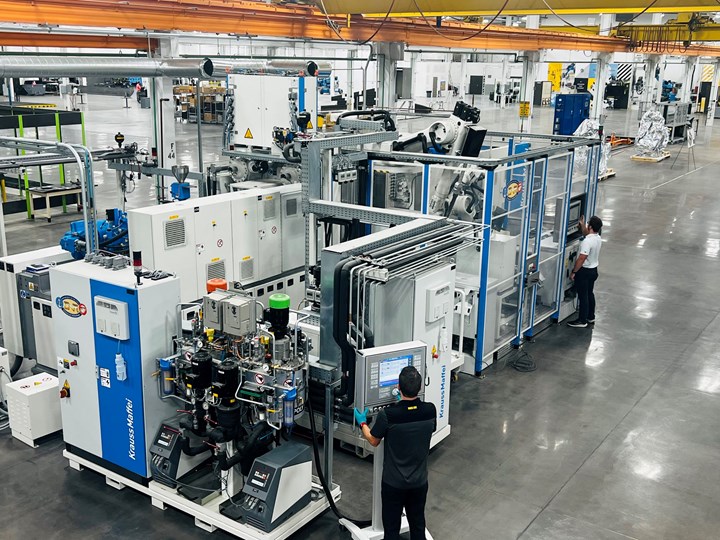
KraussMaffei commissioned a full injection molding cell to support the development of molded thermoplastic composite structures at NIAR’s ATLAS facility in Wichita. Photo Credit: Wichita State University, NIAR, ATLAS.
Waruna Seneviratne, the director of ATLAS and a senior research scientist for Composites & Structures at NIAR, notes that prior to the creation of this makerspace, many companies interested in investigating new composite structures and processes were forced to go overseas to find lab time and equipment, limiting how many businesses could afford to take on such R&D.
“In automotive we see already things like organo sheet thermoforming materials that are bonded in injection molding being utilized.”
“We wanted to democratize the access to these technologies,” Seneviratne explains. “We have established a world-class manufacturing innovation center where inventors can make ideas reality by converting laborious hand layup manufacturing processes into automated processes using advanced materials without spending a single penny on infrastructure or equipment.”
Technology Hub
The KM press, along with a 1,900-ton vertical Engel machine that can also apply HP-RTM and run molds as large as 5.7 × 7.1 feet, is located in ATLAS’s Sector A facility — a 128,000-square-foot space adjacent to Spirit AeroSystems in south Wichita. This area is also home to material supplier Solvay’s Manufacturing Innovation Center.
This particular site has a rich aviation history, dating back to its days as a key wartime production plant for Boeing. On this same site from 1943 to 1946, the facility cranked out roughly 100 B29 bombers/month — more than four airplanes a day — including the Enola Gay. From 1957 to 1963, 437 B52s were manufactured there.
Today, among other technologies, it houses the new 450-ton KM press with dual 1,400 injection units and a rotary table for multimaterial molding. The multifunction press can support high-pressure resin transfer molding (HP-RTM) as well as the ColorForm polyurethane coating technology, in addition to the integrated FiberForm infrared oven for preheating composite sheet prior to over or back molding.
“We are looking forward to engaging with the team at NIAR for future development and industrialization of the technology needed to meet the in-situ process and qualification standards of the aviation industry,” Strall says.
Applied Learning
A newly degreed engineer will theoretically have much of the book knowledge needed to enter the workforce but typically lack the real-world experience to have an immediate, productive impact. Wichita State’s applied learning model, NIAR, is changing that, according to Seneviratne, who estimates that it typically takes up to 2 years to make a new engineer productive.
As an example, when Plastics Technology visited, student trainees were busy working alongside KraussMaffei experts with more than 20 years of experience developing processes for injection molding. Similarly, in the automated fiber placement labs, students were working side-by-side with experienced staff members and engaging with certification agencies carrying out inspections and completing certification paperwork. These students are mentored by full-time ATLAS researchers and engineers with industry experience. In some labs, students were troubleshooting manufacturing issues to develop guidance materials and process specifications.
Next to ATLAS , experienced mechanics at NIAR work with students converting multiple passenger aircraft into freighters and special missions aircraft. As part of a three-year training program, the students get hands-on experience as aircraft mechanics.
“We’re set up to create an applied learning environment,” Seneviratne says, “Our technicians are getting more than just a quick 18-month textbook license. They are getting three years of intensive hands-on paid training alongside mechanics with 20 or 30 years of industry experience.”
“We’re set up to teach students and provide critical support for industry at the same time.”
As those experienced mechanics and technicians age out of the workforce, their decades of knowledge are passed on. “It’s great applied learning and, at the same time, it is a solution to get the next generation of students up to speed with an experience they cannot get from a classroom,” Seneviratne says. It’s a hands-on experience that pays in terms of the pocketbook as well. Seneviratne notes that undergraduate students working in NIAR labs with equipment like the KM press can earn a decent salary to support themselves through school while gaining hands-on experience using cutting-edge technologies.
“These undergraduate students had zero experience with advanced manufacturing technology when they started working here,” Seneviratne says. “None of them came with automation or injection molding experience, and they’re getting trained here. They’re getting paid well; getting hands-on experience with industry-scale advanced machines; and making contacts because they are working alongside industry partners on-site solving real-world problems.” Seneviratne notes that in 2022, the university paid $28 million in student salaries, not scholarships, to undergraduate students working alongside industry veterans with the very latest equipment and technologies.
In addition to getting work-ready students through the program, it also enables the advanced composite industry to test materials and structures at an otherwise impossible scale. In 2012, NIAR converted an arena into a test lab where strain gauges can run a flight profile on multiple full-scale aircraft simultaneously. “You need three things for success: cutting-edge equipment, talented people and challenging projects,” Seneviratne says, “We’re set up to teach students and provide critical support for industry at the same time.”
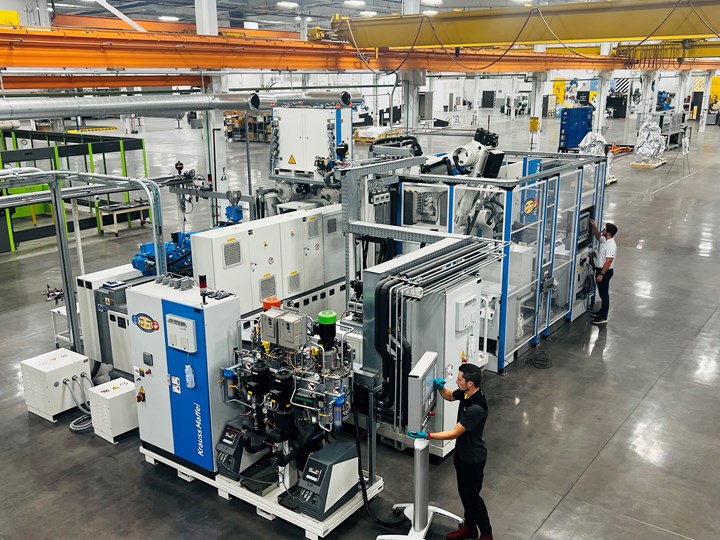
The KraussMaffei system will enable Wichita State students to learn about molded thermoplastic composite parts, while giving industry a production level machine to develop new programs. Photo Credit: Wichita State University, NIAR, ATLAS.
Related Content
Impacts of Auto’s Switch to Sustainability
Of all the trends you can see at NPE2024, this one is BIG. Not only is the auto industry transitioning to electrification but there are concerted efforts to modify the materials used, especially polymers, for interior applications.
Read MoreMasterbatch Creates Cavities, Helping Film Processors Boost Sustainability, Recyclability
Additive technology creates air pockets in film during orientation, cutting down on the amount of resin needed while boosting opacity, mechanical properties and recyclability.
Read MoreScaling Up Sustainable Solutions for Fiber Reinforced Composite Materials
Oak Ridge National Laboratory's Sustainable Manufacturing Technologies Group helps industrial partners tackle the sustainability challenges presented by fiber-reinforced composite materials.
Read MoreFor Extrusion and Injection-Blow Molders, Numerous Upgrades in Machines and Services
Uniloy is revising its machinery lines across the board and strengthening after-sales services in tooling maintenance, spare parts and tech service.
Read MoreRead Next
Technology Combines Processes for Strong, Lightweight Components
Krauss Maffei's FiberForm technology in an injection molding macine enables the production of fiber-reinforced plastic components.
Read MoreWant a Machine with Everything?
Super-flexible lab development machine is equipped for a wide range of processes.
Read MoreSee Recyclers Close the Loop on Trade Show Production Scrap at NPE2024
A collaboration between show organizer PLASTICS, recycler CPR and size reduction experts WEIMA and Conair recovered and recycled all production scrap at NPE2024.
Read More

